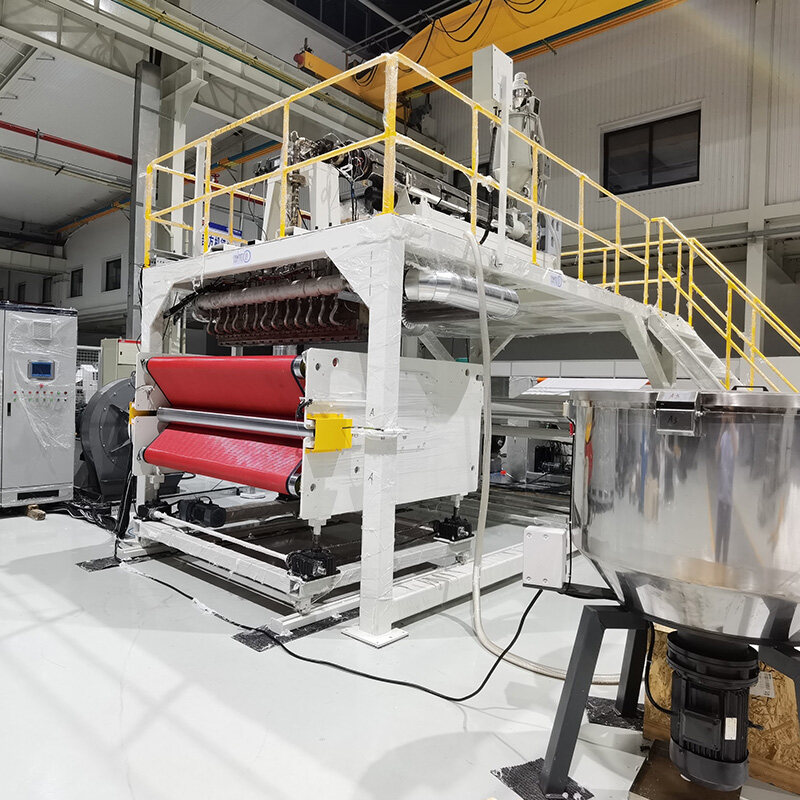Error de formato de correo electrónico
emailCannotEmpty
emailDoesExist
pwdLetterLimtTip
inconsistentPwd
pwdLetterLimtTip
inconsistentPwd

Máquina no tejida spunbond pp de cinco haces
Today, the procedure begins with the melting and extruding of thermoplastic chips. Polypropylene has been the most popular polymer for melt-blown technology up to this point. The filament is then produced by continuously filtering and measuring the extrusion. High-velocity air is used to stretch the filaments to smaller diameters, guarantee thickening occurs, and improve random filament laying. Multi-denier spinning enables the merging of spun-bonded and melt-blown materials into one nonwoven web, whereas SMS can be made offline by laminating layers of spun-bond and melt-blown webs. The web is then pre-bonded and thermally bonded as it travels through the rollers.

About Us
Fujian Jinxin Machinery Technology Co.,Ltd. was found in 2007.Our company offers variety of products which can meet your multifarious demands.We adhere to the management principles of "quality first, customer first and credit-based" and always do our best to satisfy potential needs of our customers.
We mainly produce S,SS,SSS,Meltblown,SMS,SSMS,SMMS,SSMMS,PLA,PET series nonwoven machine and laminating machine.

1.Medical: mask, protection gowns, bed sheets,drapes,shoe coves and etc.

2.Hygiene: children diaper, adult diaper, women care products and etc.

3.Packaging: shopping bags,clothes bags and etc

4.Other uses: crop protection cloth, tea bags , filter materials, lampshades, etc


Our Factory
Our product is quality proven,superior in design and produced as per the highest quality standards.Before leaving our factory,it is tested and retested for performance,productivity and durability.Through our continuous research and development, advanced skills, and a strong commitment to customer service,we are taken as a dependable supplier of China.No matter whether you are looking for a single machine or a whole production line,you can get outstanding machine and know-how results from us.Because of good quality and service,we have won a good reputation among domestic and international customers.
We hope to establish good and long-term business cooperation with customers all over the world. If you have any inquiries about our products, please feel free to contact us.



How is SSMMS manufactured?
This fabric involves two components, spunbond polypropylene, and melt-blown polypropylene. In a previous article, we briefly looked at the manufacturing process of spun-bond polypropylene
So, let's turn our attention to the melt-blown process. This process was started over 75 years ago by the US Naval Research Laboratories. The research was brought about by the desire to collect radioactive particles from the layers of Earth's upper atmosphere. To do this, it was necessary to produce fibers to be used in micro denier filters.
In the early 1970s, the first unit was completed to produce micro denier webs leading to the manufacture of fabric from the polymer using a single integrated process.
The process today starts with thermoplastic chips being melted and then extruded. To date, Polypropylene has been the most widely used polymer for melt-blown technology. The extrusion is then constantly filtered and metered to produce the filament. The use of high-velocity air stretches the filaments to finer diameters and ensures thickening occurs as well as better random laying of the filament.
Whilst SMS can be produced offline by laminating layers of spun-bond and melt-blown webs, multi-denier spinning allows for the combination of spun-bonded and melt-blown materials into one nonwoven web. This web is then pre-bonded and passes through calendar rollers for thermal bonding.
What are the applications for SSMMS?
Filtration – this is a huge market for SSMMS and includes surgical face masks, gas, and liquid filtration as well as cartridge filters.
Insulation – SSMMS has wide-ranging insulation uses including for example acoustic insulation in dishwashers.
Medical Healthcare and Sanitary products – As SSMMS can be treated with additional repellents to withstand for example alcohol, oil, and blood, this makes it an excellent fabric for the medical industry. Typical uses are surgical drapes, gowns, sterilization wraps, disposable patient sheets, female sanitary products, nappies, and incontinence products.






